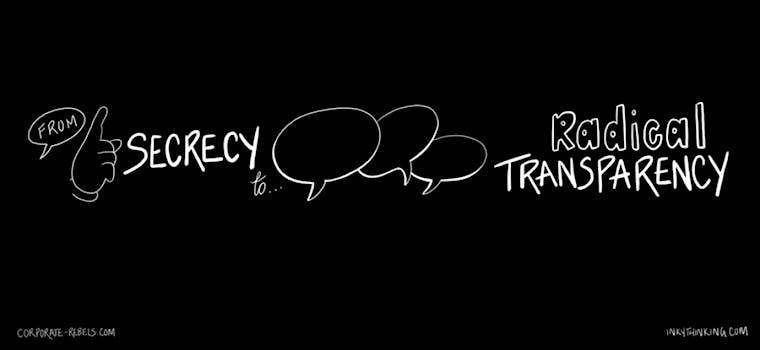5 Ways To Create A Radically Transparent Work Culture

Let’s keep it a secret. This seems to be the default option in traditional organisations. Access to valuable information is limited to a few leaders.

These top dogs must then call all the important shots. The result is little background information is shared with frontline people—those who do the ‘real’ work.
Completely clueless employees
But employees need access to information for speedy and accurate decision-making. However, the majority are completely clueless as to how their organisation really functions, and what strategies they are meant to adopt.
The result of secrecy? Distrust, ignorance, gossip and worse. How can employees really be involved if they do not know the impact of their actions, simply because essential information is withheld?
The Rebel Idea
After visiting 100+ progressive organizations it is now not a surprise that many choose a work culture based on radical transparency. They believe information must be accessible to as many as possible. They thrive by being ‘open by default’, and they encourage an ‘ask anything’ mentality. They give people the right information at the right time.
Radical transparency is a vital for progressive organisations – and a welcome change. Employees are more involved, perform better, have more faith in the organisation and in its leaders.
Rebel Idea in practice
But how do you create a culture of radical transparency? What should you think about? How do you change the way your organization works?
Some progressive organisations go very far down the rabbit hole. But don’t worry—you can start with baby steps!
Here are 5 ways companies distinguish themselves with radical transparency. We start with the simple options, and work up to the more radical ones.
1. Transparent communications
The first but extremely important step is to encourage transparent communication. Simple steps ensure everyone is involved with what is happening. For example:
- Make goals, activities and team progress visible on the walls.
- Hold short daily meetings (often stand-ups) where team members share what they are doing, and where they need help.
- Organize ‘commitment meetings’ regularly. This is when all agree what will happen in each team, and what outcomes they commit to.
- Encourage employees to use ‘social-media-like’ communication channels to easily share information. Think of ready-to-use software like Slack, Facebook Workplace, Microsoft Teams or Yammer.
- Encourage leaders to communicate with the entire organization through ‘town hall meetings’, and similar.
- Increase transparency via honest Q&A sessions like those at UKTV
2. Open by default
The second step is to make all information public—unless there is a good reason not to. This open-by-default policy ensures as many as possible have access to information.
This supports better decision-making and builds higher involvement. Use solutions like Google Drive or Microsoft Onedrive. Then, everyone has access to all sorts of useful documents.
3. Transparent performance and goals
Make sure that teams (and their members) have access to their performance data. Even more importantly, help them to compare themselves with peers.
For example, share everyone’s performance in an online table. This will create a healthy form of competition. We saw such comparison tables in organizations like Buurtzorg and Handelsbanken.
Don’t just make financial performance transparent. Also, make sure the data motivates people in the direction of the organisation’s mission!
4. Transparent financials
The next step is to introduce transparent financials. If you want truly entrepreneurial employees, they have to understand how the company works—including the money part. So, teach everyone the basics of the financials.
At Zingerman’s, the American restaurant organisation of the water-serving-CEO Ari Weinzweig, we encountered a powerful way of putting this into practice: Open Book Management (OBM). During the OBM session employees discuss the financial results of the previous week—including sales, revenue, costs, and customer satisfaction.
5. Transparent salaries
Arguably, the most advanced level of transparency is sharing salaries for the entire organisation. We have visited many organisations who have reached this level. It really shows their commitment not to hold back anything from their employees.
How do companies do that? Many roads lead to Rome. Some simply publish it, and see what happens. Others are more careful—they invite people to publish their own salaries and then get access to those of others who have chosen to do the same.
Whatever you choose, make sure you do it a fair and transparent manner!

